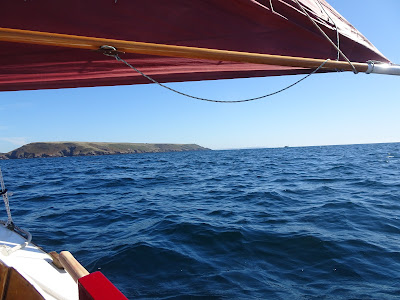Here is my part two video.
I was hoping to include the installation into Arwen but the weather has been so bad that I haven't been able to get outside to work on her.
In addition, I am still trying to decide how to do that installation. I want to make sure that the bilge pump can be moved easily between rear and forward cockpit sections.
And, to be frank, I am apprehensive about drilling a hole through Arwen's sheer plank to fit a 'thru-deck' outlet fitting. I'm wondering whether I could just stick the hose down the forward part of the centre case instead.
Anyway, here is the part two video. Forgive my poor crimping and soldering - skills I very rarely practise........as can be seen in the video!!
I've put links below to the other blogs in the series about installing the electric bilge pump, for those who want ore details about what I am doing and why I am doing it this way.
I know that there will be many who advocate installing a proper 12v big battery system. I use what I have at hand and am always reluctant to buy new stuff if I have something which will do the job I want done. Call it lazy sustainability. With a number of portable power-banks, a foldable solar power panel, my navionics on my tablet and my mobile phone and a huge range of camera batteries which always need recharging - and given I still actively cycle and trek and occasionally do overseas extended travel trips - I buy stuff that will cross all these activity areas - so far my charging of electronics in the boat, including VHF, has all been done successfully off small power banks and I will carry on with this. I am also looking at how I could use the new small 12v battery to charge some of these smaller devices as well.
Here are the links of the other blogs:
https://arwensmeanderings.blogspot.com/2020/02/installing-small-electric-bilge-pump-in_18.html
https://arwensmeanderings.blogspot.com/2020/02/installing-small-electric-bilge-pump-in.html
Postscript update:
The pump base is now attached to a piece of base wood, all smoothed and varnished appropriately. Now I just need a spell of time in the boat to put in installation points. Having just been down to Looe and chatted with some inshore small boat men and seen how they have done their bilge pumps, I have decided not to drill holes in Arwen's hull. Instead the pipe will just go strait up and over the side of the coaming. There is now 'string' securely attached to the end of the bilge pipe , some 122 back and so the pipe can be quickly loosely tied to a shroud or one of the boat tent deck eyes stretched along the side coamings to hold the pipe securely in place when pump is in use. We will review how that works first before drilling any hull holes!
I was hoping to include the installation into Arwen but the weather has been so bad that I haven't been able to get outside to work on her.
In addition, I am still trying to decide how to do that installation. I want to make sure that the bilge pump can be moved easily between rear and forward cockpit sections.
And, to be frank, I am apprehensive about drilling a hole through Arwen's sheer plank to fit a 'thru-deck' outlet fitting. I'm wondering whether I could just stick the hose down the forward part of the centre case instead.
Anyway, here is the part two video. Forgive my poor crimping and soldering - skills I very rarely practise........as can be seen in the video!!
I've put links below to the other blogs in the series about installing the electric bilge pump, for those who want ore details about what I am doing and why I am doing it this way.
I know that there will be many who advocate installing a proper 12v big battery system. I use what I have at hand and am always reluctant to buy new stuff if I have something which will do the job I want done. Call it lazy sustainability. With a number of portable power-banks, a foldable solar power panel, my navionics on my tablet and my mobile phone and a huge range of camera batteries which always need recharging - and given I still actively cycle and trek and occasionally do overseas extended travel trips - I buy stuff that will cross all these activity areas - so far my charging of electronics in the boat, including VHF, has all been done successfully off small power banks and I will carry on with this. I am also looking at how I could use the new small 12v battery to charge some of these smaller devices as well.
Here are the links of the other blogs:
https://arwensmeanderings.blogspot.com/2020/02/installing-small-electric-bilge-pump-in_18.html
https://arwensmeanderings.blogspot.com/2020/02/installing-small-electric-bilge-pump-in.html
The pump base is now attached to a piece of base wood, all smoothed and varnished appropriately. Now I just need a spell of time in the boat to put in installation points. Having just been down to Looe and chatted with some inshore small boat men and seen how they have done their bilge pumps, I have decided not to drill holes in Arwen's hull. Instead the pipe will just go strait up and over the side of the coaming. There is now 'string' securely attached to the end of the bilge pipe , some 122 back and so the pipe can be quickly loosely tied to a shroud or one of the boat tent deck eyes stretched along the side coamings to hold the pipe securely in place when pump is in use. We will review how that works first before drilling any hull holes!




































